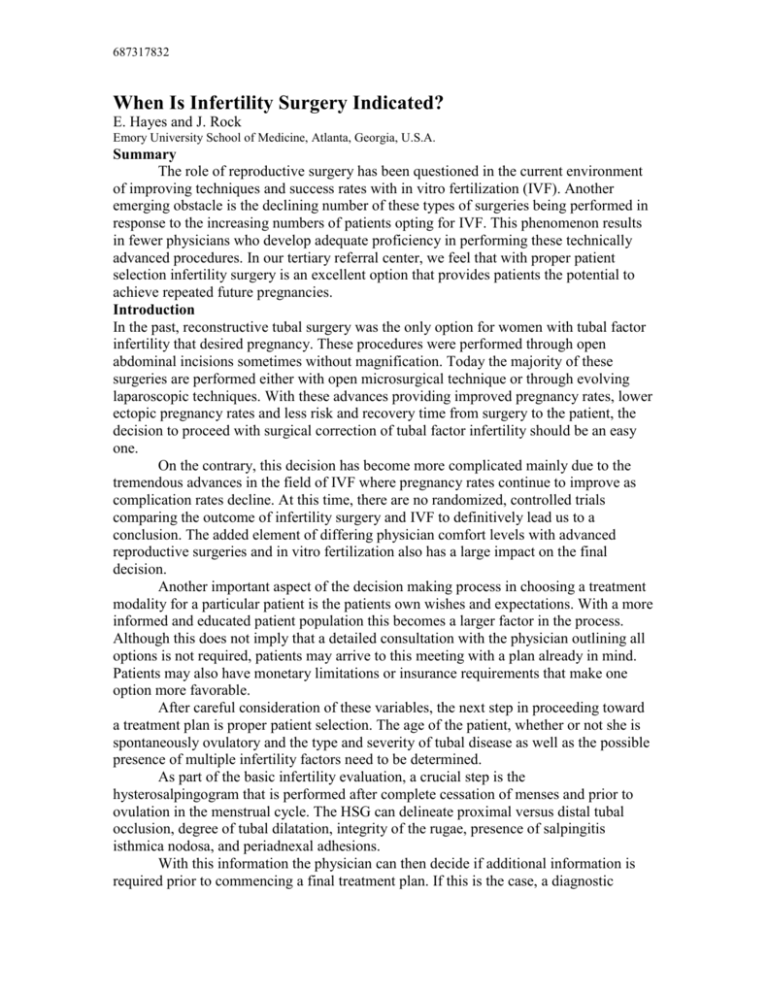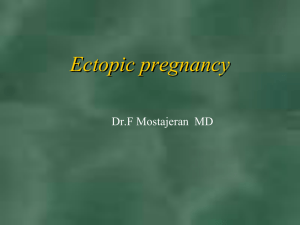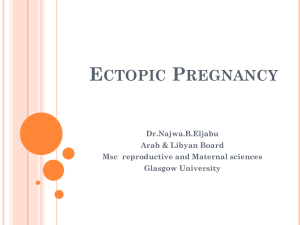When is infertility surgery indicated
advertisement

687317832 When Is Infertility Surgery Indicated? E. Hayes and J. Rock Emory University School of Medicine, Atlanta, Georgia, U.S.A. Summary The role of reproductive surgery has been questioned in the current environment of improving techniques and success rates with in vitro fertilization (IVF). Another emerging obstacle is the declining number of these types of surgeries being performed in response to the increasing numbers of patients opting for IVF. This phenomenon results in fewer physicians who develop adequate proficiency in performing these technically advanced procedures. In our tertiary referral center, we feel that with proper patient selection infertility surgery is an excellent option that provides patients the potential to achieve repeated future pregnancies. Introduction In the past, reconstructive tubal surgery was the only option for women with tubal factor infertility that desired pregnancy. These procedures were performed through open abdominal incisions sometimes without magnification. Today the majority of these surgeries are performed either with open microsurgical technique or through evolving laparoscopic techniques. With these advances providing improved pregnancy rates, lower ectopic pregnancy rates and less risk and recovery time from surgery to the patient, the decision to proceed with surgical correction of tubal factor infertility should be an easy one. On the contrary, this decision has become more complicated mainly due to the tremendous advances in the field of IVF where pregnancy rates continue to improve as complication rates decline. At this time, there are no randomized, controlled trials comparing the outcome of infertility surgery and IVF to definitively lead us to a conclusion. The added element of differing physician comfort levels with advanced reproductive surgeries and in vitro fertilization also has a large impact on the final decision. Another important aspect of the decision making process in choosing a treatment modality for a particular patient is the patients own wishes and expectations. With a more informed and educated patient population this becomes a larger factor in the process. Although this does not imply that a detailed consultation with the physician outlining all options is not required, patients may arrive to this meeting with a plan already in mind. Patients may also have monetary limitations or insurance requirements that make one option more favorable. After careful consideration of these variables, the next step in proceeding toward a treatment plan is proper patient selection. The age of the patient, whether or not she is spontaneously ovulatory and the type and severity of tubal disease as well as the possible presence of multiple infertility factors need to be determined. As part of the basic infertility evaluation, a crucial step is the hysterosalpingogram that is performed after complete cessation of menses and prior to ovulation in the menstrual cycle. The HSG can delineate proximal versus distal tubal occlusion, degree of tubal dilatation, integrity of the rugae, presence of salpingitis isthmica nodosa, and periadnexal adhesions. With this information the physician can then decide if additional information is required prior to commencing a final treatment plan. If this is the case, a diagnostic 687317832 laparoscopy with chromopertubation may be warranted to directly visualize the pelvic anatomy and possible pelvic adhesive disease or endometriosis. Once all necessary information has been obtained an informed decision and appropriate treatment plan can be formulated between patient and physician. In this summary of the pertinent literature we attempt to provide evidence that infertility surgery is an excellent option for many patients with tubal factor infertility as well as discuss patients that would be better served by proceeding directly to in vitro fertilization. Materials and Methods We performed a search of MEDLINE and the Cochrane Database of Systematic Reviews. Pertinent articles were referenced. Results Periadnexal adhesive disease Periadnexal adhesive disease may be a sole contributor to tubal factor infertility or may exist in conjunction with fimbrial phimosis or tubal occlusion. Adhesions may also form from a prior sterilization procedure, prior pelvic inflammatory disease or endometriosis. Regardless of the etiology, adhesiolysis has been shown to significantly increase the pregnancy rate. It has been demonstrated that there is no difference in pregnancy rates between adhesiolysis performed with the CO2 laser and that done with electrocautery. Adhesiolysis can be effectively performed with either open microsurgical technique or with laparoscopy with similar pregnancy rates. If an open procedure is the chosen approach, there is an increased pregnancy rate and decreased rate of ectopic pregnancies with use of magnification. The overall intrauterine pregnancy rate after salpingoovariolysis is 51-62% and the rate of ectopic pregnancy is 5-8%. It is therefore preferable to use a laparoscopic approach as the procedure of choice in this clinical scenario with laparotomy reserved for cases unable to be completed laparoscopically. When laparotomy is required, microsurgical technique with magnification should be employed. Proximal tubal occlusion Proximal tubal occlusion occurs in 10-25% of women with tubal factor infertility. The majority is due to salpingitis isthmica nodosa, chronic salpingitis, intratubal endometriosis, tubal spasm, or amorphous material. There are currently no randomized controlled trials that compare selective tubal cannulation procedures performed hysteroscopically or under fluoroscopic guidance to surgery. In non-randomized studies similar intrauterine pregnancy rates have been found in patients undergoing tubal cannulation and those who undergo microsurgical tubocornual anastomosis. The intrauterine pregnancy rate is 33-56% and the ectopic pregnancy rate is 5-7%. Because of the minimally invasive nature of the procedure with similar outcome it is preferential to attempt selective tubal cannulation under hysteroscopic or fluoroscopic guidance first. If this is unsuccessful it would then be appropriate to proceed to microsurgical tubocornual anastomosis. 687317832 Patients with concomitant proximal and distal tubal occlusion should be considered separately as they have an extremely poor prognosis with either type of procedure. These patients with bipolar tubal disease should be counseled to proceed directly to IVF. Fimbrial phimosis Fimbrial phimosis, or agglutination of the fimbria of the fallopian tube, frequently occurs simultaneously with periadnexal adhesions. There is minimal data looking specifically at fimbrial phimosis as this data is often pooled with salpingostomy data, however it has been demonstrated that intrauterine and ectopic pregnancy rates are similar for laparoscopic and open microsurgical fimbrioplasty. The intrauterine pregnancy rate is 40-48% and the ectopic pregnancy rate is 5-6%. The first choice for fimbrioplasty would be a laparoscopic approach as patient morbidity and recovery time is minimized. This approach is also conducive to salpingoovariolysis, which is frequently necessary. Open microsurgical fimbrioplasty should be reserved for cases unable to be performed laparoscopically. Distal tubal occlusion When considering the patient with distal tubal occlusion for surgical treatment it is imperative that patients are selected carefully. As previously stated, patients with bipolar tubal disease are poor surgical candidates and achieve significantly better pregnancy rates with IVF. The next step in careful patient selection is determination of the severity of tubal disease. Multiple studies have shown that prognosis is directly correlated to degree of tubal damage. Tubal disease can be classified as mild, moderate, or severe based on the extent of tubal dilatation, tubal wall thickness, rugal integrity, status of the fimbria, and degree of adnexal adhesions. Patients determined to have severe tubal disease have an overall intrauterine pregnancy rate of only 16% after salpingostomy and should therefore be advised to proceed directly to IVF. Data support salpingectomy in these patients with hydrosalpinges visible on ultrasound prior to commencing the IVF cycle to improve implantation and pregnancy rates. In patients with mild or moderate tubal disease surgery is a viable option and this can be performed with either an open microsurgical technique or a laparoscopic approach. Data show that open microsurgery results in a slightly higher intrauterine pregnancy rate than laparoscopy. It has also been shown that pregnancy rates in open procedures are independent of the salpingostomy technique used. Intrauterine pregnancy rates in patients with mild tubal disease are 80% and 31% in moderate disease. Ectopic pregnancy rates are 5-18%. The data support open microsurgical salpingostomy as the first line surgical approach for patients with mild or moderate disease with laparoscopic salpingostomy showing slightly reduced pregnancy rates. Prior tubal sterilization The success of surgical reversal of a prior tubal sterilization procedure is dependent on several factors including the type of sterilization procedure performed, the site of tubal anastomosis, and the length of the reconstructed fallopian tube. It is necessary that the patient have at least 4cm of functional tube remaining preferably with at least 2cm in the ampullary portion as well as intact fimbria. 687317832 Tubal anastomosis may be performed with open microsurgical technique or by laparoscopy with similar results provided the same meticulous surgical technique is maintained. Physician preference plays a large role in this decision. When open microsurgery is chosen, the intrauterine pregnancy rate is increased and the ectopic pregnancy rate decreased with use of magnification. There has been no significant difference in pregnancy rates demonstrated between magnification with surgical loupes or the operating microscope. The overall intrauterine pregnancy rate is 60-80% and the ectopic pregnancy rate is 2-12.5%. In patients who have undergone surgical sterilization by fimbriectomy, most data support proceeding directly to in vitro fertilization, however more recent data suggest that in the correct patient cohort surgery may be an option. Patients with a remaining tubal length of >7cm may be candidates for salpingostomy with pregnancy rates approaching 30%. Failure of the first reconstructive procedure Patients in this category have extremely low success rates when additional infertility surgical procedures are attempted. These patients should be advised to proceed to IVF. Conclusions The first step in determining if a patient is an appropriate candidate for infertility surgery is thorough evaluation including a hysterosalpingogram to accurately diagnose the anatomic location and severity of tubal disease. At this point, the physician may choose to proceed with a diagnostic laparoscopy to directly view the pelvic anatomy. When evaluation is complete, one must consider all other factors including patient age, presence of spontaneous ovulation, presence of concomitant male factor infertility, as well as the patient’s own wishes. If these factors dictate that the patient would be a poor candidate for surgical intervention the patient should be counseled to proceed with IVF. In the patient cohort found to be appropriate for surgery this is an excellent option. Patients with pelvic adhesive disease should proceed first with laparoscopic adhesiolysis, with laparotomy using microsurgical technique reserved for severe cases. This can also be said for patients with fimbrial phimosis where laparoscopic fimbrioplasty should be the first line therapy. In the case of proximal tubal occlusion, selective tubal cannulation should be attempted first with microsurgical tubocornual anastomosis reserved for failures. In distal tubal occlusion, patients with mild or moderate disease should undergo open microsurgical salpingostomy for best pregnancy rates. Patients with severe or bipolar tubal disease should be advised to undergo IVF for best results. Patients who have undergone prior tubal sterilization may undergo open microsurgical or laparoscopic tubal anastomosis depending on physician preference if they meet the anatomic criteria of at least 4cm of functional tube remaining. Patients with prior fimbriectomy sterilization must have >7cm of tube remaining to be candidates for salpingostomy. In patients that have failed after their first reconstructive surgery, IVF should be recommended. References Audibert F, Hedon B, Arnal F, Humeau C, Boulot P, Bachelard B, Benos P, Laffargue F, Viala JL. Therapeutic strategies in tubal infertility with distal pathology. Hum Reprod, 6, 1439-1442, 1991. 687317832 Camus E, Poncelet C, Goffinet F, Wainer B, Merlet F, Nisand I, Phillipe HJ. Pregnancy rates after in vitro fertilization in cases of tubal infertility with and without hydrosalpinx: a meta-analysis of published comparative studies. Hum Reprod, 14, 1243-1249, 1999. Canis M, Mage G, Pouly JL, Manhes H, Wattiez A, Bruhat MA. Laparoscopic distal tuboplasty: report of 87 cases and a 4-year experience. Fertil Steril, 17, 511-515, 1991. Chong AP. Pregnancy outcome in neosalpingostomy by the cuff vs Bruhat Technique using the carbon dioxide laser. J Gynecol Surg, 7, 207-210, 1991. Diamond M, Freeman M. Clinical implications of postsurgical adhesions. Hum Reprod Update, 7, 567-576, 2001. Gomel V. Reconstructive Tubal Surgery. Te Linde’s Operative Gynecology, Philadelphia, Lippincott, Williams & Wilkins, 2002. Honore G, Holden A, Schenken R. Pathophysiology and management of proximal tubal blockage. Fertil Steril, 71, 785-795, 1999. Kasia JM, Raiga J, Doh AS, Biouele JM, Pouly JL, Kwiatkowski F, Edzoa T, Bruhat MA. Laparoscopic fimbrioplasty and neosalpingostomy. Eur J Obstet Gyn Reprod Bio, 73, 71-77, 1997. Reich H. Laparoscopic treatment of extensive pelvic adhesions, including hydrosalpinges. J Reprod Med, 32, 736-742, 1987. Rock JA, Bergquist CA, Kimball AW, Zacur HA, King TM. Comparison of the operating microscope and loupe for microsurgical tubal anastomosis: a randomized controlled clinical trial. Fertil Steril, 41, 229-232, 1984. Schlaff WD, Hassiakos DK, Damewood MD, Rock JA. Neosalpingostomy for distal tubal obstruction: prognostic factors and impact of surgical technique. Fertil Steril, 54, 984-990, 1990. Strandell A, Lindhard A, Waldenstrom U, Thorburn J. Hydrosalpinx and IVF outcome: cumulative results after salpingectomy in a randomized controlled trial. Hum Reprod, 16, 2403-2410, 2001. Tulandi T. Salpingo-ovariolysis: a comparison between laser surgery and electrosurgery. Fertil Steril, 45, 489-491, 1986. Tulandi T, Collins JA, Burrows, Jarrell JF, McInnes RA, Wrixton W, Simpson CW. Treatment dependent and treatment independent pregnancy among women with periadnexal adhesions. Am J Obstet Gynecol, 162, 354-357, 1990. Tulandi T, Vilos GA. A comparison between laser surgery and electrosurgery for bilateral hydrosalpinx: a 2-year follow-up. Fertil Steril, 44, 846-847, 1985. Tourgemen DE, Bhaumik M, Cooke GC, Najmabadi S, Paulson RJ, Jain JK. Pregnancy rates following fimbriectomy reversal via neosalpingostomy: a 10-year retrospective analysis. Fertil Steril, 76, 1041-1044, 2001. Watson A, Vanderkerckhove P, Lilford R. Techniques for pelvic surgery in subfertility (Cochrane Review). In: The Cochrane Library, Issue 1, 2002.







